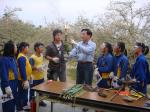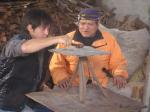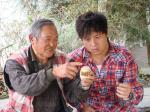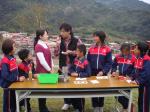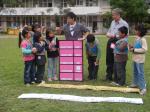Category Archives: Bunun
Episode 87: Tremor Fishing
In the Bunon tribe, there is a traditional fishing method that uses the tremor of rocks to disorient fish in the rocks. Because of the immense sound produced by the clashing of two rocks, the sound wave can make the fish dizzy, and the Bunon can easy catch the fish.
Episode 82: Derris
Using vines with paralyzing agents has always been used in early fishing methods. What is derris, and how does it paralyze a fish?
The most effective part of a derris is its roots. It can not only paralyze a fish, but it could also do it very quickly. However, because it is so effective, and it can influence a wide area, the use of derris has been restricted very early on.
Episode 72: Resin Lamp
Resin actually has a lot of viscosity. The Bunon people would use it as a glue when making instruments. But, where did the resin come from? In the Bunon tradition, they only take resin from trees that were wore down by animals. They do not cut open trees to get them. Resin are also used in ceremonies. It symbolizes passing down the torch. Therefore, the resin bears a special meaning for the Bunon people.
The science teacher shows us that the resin can even be used as a torch! The Bunon ancestors sure are clever!
Episode 71: Whipping Top
During the free time between planting and weeding, Bunon boys spin tops for entertainment. They use whips to make tops go as fast as they can. The game symbolizes Bunon’s wish for millets to grow faster. The teacher explains the best place to whip the top as well as the behavior of the axis before it stops.
Episode 70: Preservation with Wood Ash
Before there were refrigerators, indigenous peoples would smoke meat to preserve it. However, there is another way to preserve food. This episode’s indigenous expert uses wood ash to seal bottles. Using water, wood ash can be hardened to prevent molds and repel bugs. Sometimes they would use smoke to get rid of bugs in the house. It works the same way for food! This kind of natural preservative is even better and healthier than modern artificial preservatives! By absorbing the moisture in the air, wood ash can stave off the black beans’ expiration date.
Episode 68: Picture Calendar
The Bunon uses the lunar calendar. A year is divided into 12 months, and one month into 30 days. They use knots to record days. One knot equals one day. 30 knots fills a month. When hunters go into the mountains to hunt, they also use knots to record days. In this episode, Taws shows us the different phases of the moon. When the Earth, Moon, and the Sun is one line, that is the first of a lunar month, and we can’t see the moon. One rotation of the moon equals one month.
Episode 55: Mountain Spring Pipe
In this episode, the science teacher shows kids the principle behind siphoning. Liquid moves from an upper reservoir to a lower reservoir because the pressure of the liquid in the end of the tube is greater than the surrounding pressure in the lower reservoir. When the water level of the two reservoirs are the same, and their atmospheric pressures are equal, the siphoning stops. Also, if air is in the tube, then the water would not flow. That’s why the villages always need ventilation pipe to discharge the air for the water to flow smoothly.
Episode 53: Pestle Playing
Bunun’s pestle playing uses 8 to 16 wooden pestles. By taking turns tapping on the stone tablet, the different notes could produce beautiful melodies. Through experiments, the science teacher of this episode helps kids to understand the creation of sound, and realize that the different sizes of the pestles can create different notes. The shorter the pestle, the higher the tone.
Episode 51: Filtering Muddy Water
When there is no clean water in the mountains, what should one do? This episode of Little Science Hunters is filled with different kinds of water filtering materials, such as using a bamboo as a straw, using a cloth as a simple filter, and one could drink the water immediately. In this episode, the teacher helps the students understand the circulatory system. After exercising, one’s body temperature would rise, the heart rate would increase, as well as the blood flow. It is the body trying to get rid of heat and waste.






